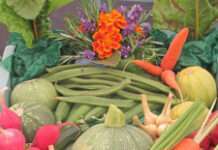ANNOUNCEMENTS
K-State Garden Hour Webinar Series Begins This Week
We are very excited for the K-State Garden Hour webinar series that begins this week on Wednesday, February 17th. We will kick off the spring series with the topic, “Planning Your Vegetable Garden” by Tom Buller. These webinars will be held live the first and third Wednesday of each month, from noon to 1:00pm CST. Presentations will also be recorded and available online to watch following the event. This year, there is only one registration required. This one-step registration will allow participants to participate in any of the featured topics within the 2021 K-State Garden Hour. It will also remind past participants/ registered participants of the upcoming live event, as well as notify them when the recording is available. To register and see a listing of upcoming webinars as well as links to previous webinars, go to http://ksre-learn.com/KStateGardenHour.
REMINDERS
1. Draw vegetable garden layout.
2. Replace or add mulch as needed.
TURFGRASS
Lawn Calendar for Cool-Season Grasses
The following suggestions are for cool-season grasses such as Kentucky bluegrass or tall fescue. Zoysia grass, bermudagrass, and buffalo grass are warm-season grasses and require a different maintenance regime. A warm-season grass calendar will be covered in a later newsletter.
March
Spot treat broadleaf weeds if necessary. Treat on a day that is 50 degrees or warmer. Rain or irrigation within 24 hours of application will reduce effectiveness.
April
Apply crabgrass preventer when redbud trees are in full bloom, usually in April. The preventer needs to be watered in before it will start to work. One-quarter inch of water will be enough to water in any of the products commonly available. Remember that a good, thick lawn is the best weed prevention and may be all that is needed.
May
Fertilize with a slow-release fertilizer if you water your lawn or if you normally receive enough rainfall that your turf doesn’t go drought-dormant during the summer. If there are broadleaf weeds, spot treat with a spray or use a fertilizer that includes a weed killer. Rain or irrigation within 24 hours of application will reduce effectiveness of the weed killer, but the fertilizer needs to be watered in. If you are using a product that has both fertilizer and weed killer, wait 24 hours after application before watering in. If grubs have been a problem in the past, apply a product containing imidacloprid or chlorantraniliprole during May or anytime from May through June for imidacloprid. These products work to prevent grub damage. If rainfall does not occur within 24 hours, irrigate with 1/4″ of water.
June through Mid-July
Apply second round of crabgrass preventer by June 15 – unless you have used Dimension (dithiopyr) or Barricade (prodiamine) for the April application. These two products normally provide season-long control with a single application. Remember to water it in.
Late-July through August
If you see grub damage, apply a grub killer that contains Dylox. Imidacloprid and chlorantraniliprole are effective against young grubs but may not be effective on late instar grubs. The grub killer containing Dylox must be watered in within 24 hours or effectiveness drops.
September
Fertilize around Labor Day. This is the most important fertilization of the year. Water in the fertilizer if rainfall does not occur.
November
Fertilize. This fertilizer is taken up by the roots but is not used until the following spring. Water in fertilizer. Spray for broadleaf weeds even if they are small. Broadleaf weeds are much easier to control in the fall than in the spring. Try to spray on a day that is at least 50 degrees. Rain or irrigation within 24 hours reduces effectiveness. Use label rates for all products! (Ward Upham)
VEGETABLES
Planting Asparagus
Though it is too early to plant asparagus, it is not too early to make plans and prepare the soil. This crop is a perennial and will survive for many years if given proper care. It prefers full sun and a well-drained soil and is usually placed on the edge of the garden area so that there is no need to till around the area to plant other crops.
Proper soil prep is especially important for perennial crops. Take a soil test to ensure proper levels of nutrients. See the accompanying article on how to take a soil test for the correct procedure.
Work the soil as early in the spring as possible but do not work wet soil as clods will form. Then add two inches of organic matter to the surface and the fertilizer and work again so the organic matter and fertilizer are blended into the soil.
Asparagus can be propagated from seed but is more often started from 1-year-old crowns. These crowns are planted deeply; 6 to 8 inches deep either in a hole for each crown or in a trench with shallower planting recommended for soils with more clay. Space plants 18 to 24 inches apart. Fill in the trench gradually over the growing season to encourage growth.
March 15 to April 15 is the best planting time. Adapted varieties include Jersey Giant, Jersey King, Jersey Knight, Jersey Supreme and Purple Passion. These are all male hybrids that will produce three times as much as our old Martha or Mary Washington varieties.
Males have a number of advantages over females in that they live longer, emerge earlier in the spring, are more productive and eliminate potential volunteer plants that can reduce the productivity of a planting.
Weed control is very important. Competition with weeds results in slow establishment. A shallow hoeing should be all that is needed. (Ward Upham)
FLOWERS
Fertilizing Spring-flowering Bulbs
The best time to fertilize spring-flowering bulbs is when foliage emerges in the spring rather than at flowering. Traditionally, gardeners have applied fertilizer during bloom or a bit after, but because bulb roots start to die at flowering, fertilizer applied at bloom is wasted. Roots are active when the foliage first pokes through the ground. Nutrients applied then help the plant produce flowers the following year. If bulbs have been fertilized in the past, there is often plenty of phosphorus and potassium in the soil. It is best to take a soil test to be certain.
If the soil needs phosphorus and potassium, use a complete fertilizer (such as 10-10-10, 9-9-6, etc.) at the rate of 2.5 lbs. per 100 square feet. This would equal 1 rounded teaspoon per square foot. If phosphorus and potassium are not needed, blood meal makes an excellent fertilizer. It should be applied at the rate of 2 lbs. per 100 square feet or 1 teaspoon per square foot. Lawn fertilizers such as a 27-3-3 or 30-3-3 can be used, but cut the rate to a third of that applied for blood meal. Also make sure the lawn fertilizer does not contain a weed preventer or weed killer.
Remember to leave the foliage until it dies naturally. The energy in the foliage is transferred to the bulb as the foliage dies and will help the bloom for the next year. (Ward Upham)
MISCELLANEOUS
Soil Testing
Most gardeners think that soil tests are done only to find out what nutrients are deficient. However, it is just as important to know if you have adequate levels of nutrients so you don’t add unneeded fertilizer. The most basic soil test checks pH and the levels of phosphorus and potassium. Most of the lawn and garden soil tests that come out of our soil-testing lab show more than adequate levels of both phosphorus and potassium. If those nutrients are not needed, applying them is a waste of money and can be a source of pollution. In extreme cases, excess phosphorus can interfere with the uptake of micronutrients. So, if you haven’t taken a soil test in several years, take one this spring.
Begin by taking a representative sample from a number of locations in the garden or lawn. Each sample is composed of about 8 sub-samples that go from the surface to 6 to 8 inches deep. Mix the sub-samples together in a clean container and select about 1 pint of soil. For more detail on taking a soil test, click here and choose “Soil Analysis” in the left column.
Take the soil to your local K-State Research and Extension office to have tests done at the K-State soil-testing laboratory for a fee. A soil test determines fertility problems, not other conditions that may exist such as poor drainage, poor soil structure, soil borne diseases or insects, chemical contaminants or damage, or shade with root competition from other plants (see accompanying article). All of these conditions may reduce plant performance but cannot be evaluated by a soil test. (Ward Upham)
Soil Tests When Soils are Wet
If your soil is wet, it would be best to wait until the soil dries before taking samples. Though it is possible to take soil tests when soils are wet, there are precautions.
Soil samples should be air-dried before being submitted for testing. Do NOT use artificial means of drying such as an oven or microwave as such treatment may result in inaccurate readings of nutrient levels. Also, be sure to use a clean container to collect the sample. Wet samples are more likely to absorb foreign materials adhering to the container, which may also influence soil test results.
For more detail on taking a soil test, click here and choose “Soil Analysis” in the left column. Then click “Sample Collection” at the bottom of the center column.
Take the sample into your local extension office. If you don’t know the address for your local, county extension office, see http://www.ksre.ksu.edu/Map.aspx (Ward Upham)
Gardening Calendar
The Kansas Healthy Yards website has a gardening calendar that many gardeners find helpful. It lists all the months of the year and the chores that can be done during that month. Each month is divided into separate sections such as Vegetables and Fruits, Flowers, Lawns, Trees and Shrubs and Houseplants. Not all suggestions will be helpful each year but are important to have included. For example, one of the January tips is on removing snow and ice on limbs. You may brush off the snow, if desired, but ice should be allowed to melt naturally.
To find the gardening calendar, go to http://kansashealthyyards.org/ and click on “Gardening Calendar” in the gray bar at the top of the page. (Ward Upham)
What a Soil Test Does Not Tell You
Though soil tests are useful for identifying nutrient deficiencies as well as soil pH, they do not tell the whole story. We often receive soils from gardeners that are having a difficult time growing crops even though the soil test shows the pH is fine and nutrients are not deficient. Here are some factors that can affect plant growth that are not due to nutrient deficiencies or pH.
Not enough sun: Plants need a certain minimum amount of sun before they will grow well. As a general rule, flowering (and fruiting) plants need at least 6 to 8 hours of full sun per day. There are, of course, exceptions such as impatiens that bloom well in shade. Move sun-loving plants into more sun or use plants that are better adapted to shady conditions.
Poor soil physical characteristics: Roots need oxygen as much as they need water. A tight clay soil or excessive water can restrict soil oxygen levels as well as make root penetration of the soil difficult. Increasing the organic matter content of clay soils can help rebuild good structure. Add a 2-inch layer of organic matter and till it in.
Walnut trees: Walnuts give off a natural herbicide that interferes with the growth of some plants such as tomatoes. Vegetable gardens should be at least 50 feet away from walnut trees if possible. For a listing of plants that are susceptible to walnut, go to: http://www.omafra.gov.on.ca/english/crops/facts/info_walnut_toxicity.htm Tree roots: Trees not only compete with other plants for sun but also for water and nutrients. Extra water and nutrients may be needed.
Shallow soils: When new homes are built, the topsoil is often stripped off before the soils are brought to grade. Though the topsoil should be replaced, it sometimes is not or is not replaced to the same depth as it was originally. You are left with a subsoil that usually does not allow plants to grow well due to a lack of soil structure. Adding topsoil to a depth of 8 to 12 inches would be best but this often is not practical. In such cases, try to rebuild structure by adding organic matter and working it into the soil.
In other cases, a thin layer of soil may be spread over rock or construction debris. Plantings in shallow soils will wilt and die more quickly than other plants that are on a deeper soil. Use a soil probe to find such obstructions.
Too much phosphorus: Most Kansas soils are naturally low in phosphorus. However, soils that have been fertilized for a number of years may have phosphorus levels that are quite high. As a matter of fact, the majority of soil tests we receive show phosphorus levels in the “high” category. Extremely high phosphorus levels can interfere with the uptake of some micronutrients such as iron, manganese and zinc.
High phosphorus soils should only be fertilized with fertilizers that have no or relatively low amounts of phosphorus.
Improper watering: Roots develop where conditions are best for growth. Shallow, frequent watering leads to roots developing primarily near the surface of the soil where the soil is moist. Such shallow root systems are easily damaged by heat and any interruption in the watering schedule. It is better to water less frequently and to a greater depth to encourage a deeper root system that is less sensitive to heat and water stress.
Watering during the evening can also be detrimental to plants if the irrigation wets the foliage. Many diseases are encouraged by free water on the leaves. Watering late in the day often will keep the foliage wet until dew forms. Dew will keep the foliage wet until it evaporates the next morning. It is better to water early in the morning so leaves do not stay wet as long. If you must water late in the day, use drip irrigation if practical (such as in a vegetable garden).
Overwatering: Roots need to breathe. In other words, they must have oxygen in order to survive. Be careful to not water so heavily that the soil remains saturated. Water deeply but allow soil to dry somewhat between waterings. (Ward Upham)
Contributors: Ward Upham, Extension Associate
Division of Horticulture
1712 Claflin, 2021 Throckmorton
Manhattan, KS 66506
(785) 532-6173
For questions or further information, contact: [email protected] OR [email protected]
This newsletter is also available on the World Wide Web at:
http://hnr.k-state.edu/extension/info-center/newsletters/index.html
The web version includes color images that illustrate subjects discussed. To subscribe to this newsletter electronically, send an e-mail message to [email protected] or [email protected] listing your e-mail address in the message.
Brand names appearing in this newsletter are for product identification purposes only. No endorsement is intended, nor is criticism implied of similar products not mentioned.
K-State Research and Extension is committed to making its services, activities and programs accessible to all participants. If you have special requirements due to a physical, vision or hearing disability, or a dietary restriction please contact Extension Horticulture at (785) 532-6173.
https://hnr.k-state.edu/extension/info-center/newsletters/index.html
Blog Post: http://www.ksuhortnewsletter.org
Video of the Week: Growing Asparagus
https://kansashealthyyards.org/all-videos/video/growing-asparagus
Ward Upham
Extension Associate
[email protected]
785-532-1438





